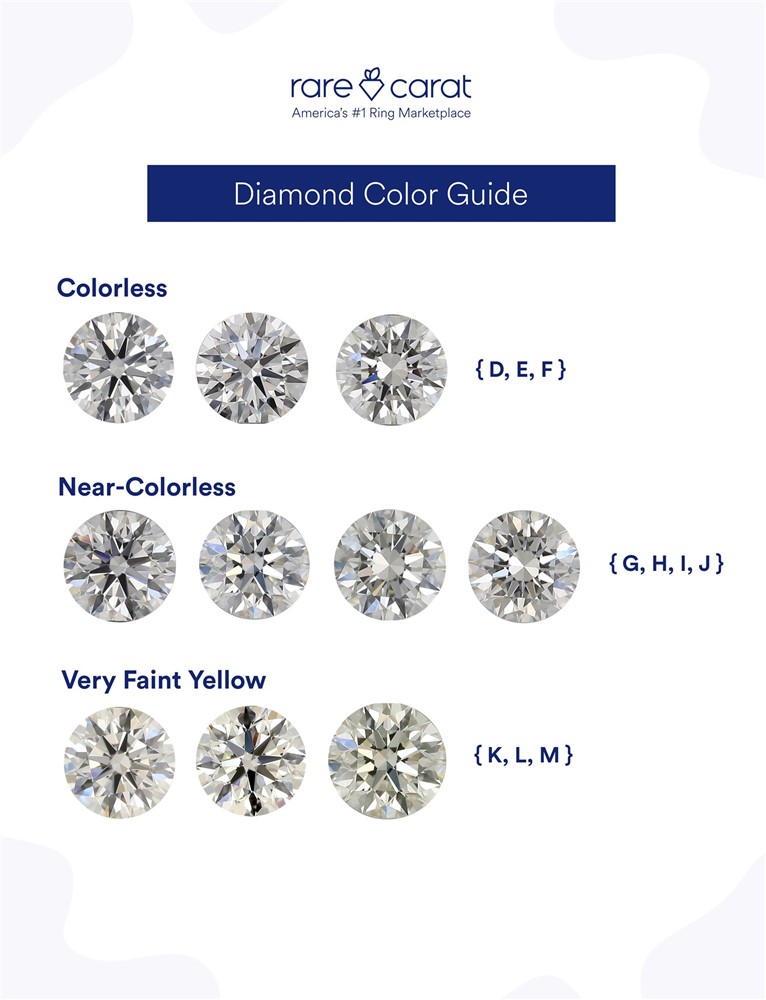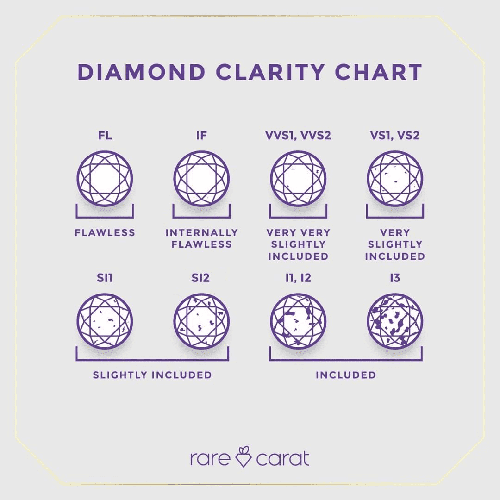What Color And Clarity Are Good For A Diamond? | Rare carat
Shopping for diamonds can be stressful. First of all, it’s a lot of money. Secondly, it’s unfamiliar territory for most people. On top of everything, there is specific jargon used to describe both the color and clarity of diamonds which you may not be familiar with. When working in retail, often I would finish a description of a stone and then be asked by the customer, “is that good?” This is a fair question. However, the word “good” is subjective by nature. As a gemologist, it is my job to understand what factors are important to you, the buyer, and guide you to a “good” diamond which fulfills your unique needs and expectations. Let’s dive into the details regarding diamond color and clarity so that, when you decide that it’s time to purchase a diamond, you can do so with confidence and enthusiasm!
Color
The color of diamonds is graded on the “normal color range” scale developed by the Gemological Institute of America (GIA) in the 1950s. This system ranks colorless diamonds from D-to-Z where D represents purely colorless stones and Z signifies yellowish, brownish, or greyish stones which are just shy of having enough color to be considered “fancy-colored”. A-C are excluded from this system because they were used indiscriminately prior to the implementation of the GIA’s standardized scale.
Each letter in this scale represents the smallest perceptible change in color from its neighbor when examined by a trained professional. Distinguishing the exact color grade of a stone can’t just be “eyeballed” and instead requires the examining gemologist to use specific lighting conditions and compare the diamond to a set of stones with known colors. When considering color alone, the highest value is associated with D stones and prices decrease with each step down the alphabet.
Color grading diamonds is a highly technical process, but, what will YOU notice on an everyday basis? While each color grade is distinctive (and vital when considering value), letters are grouped into five broad categories to help describe what you will perceive: Colorless (D-F), Near Colorless (G-J), Faint (K-M), Very Light (N-R), and Light (S-Z).

Colorless:
If you want a truly colorless stone and don’t mind paying a premium, this is the category for you. These white stones shimmer without a hint of color. For all intents and purposes, colors D-F appear the same to the naked eye. However, there is a huge jump in price between D and E colors. If you want to make a financial investment in a “perfect” stone, go all out and find a beautiful D! If you want the colorless look but don’t want to pay top dollar, F is a sensible choice.
Near Colorless:
For most, G-J colors hit the sweet spot. They are colorless enough to appear white but don’t command prices nearly as high as Colorless stones do. An educated eye may detect some warm color in I and J stones, but the effect is minimal. Also, bear in mind that the color of the mounting will affect the perceived color of diamonds because stones absorb some of the color of their surroundings. White metal mountings will brighten the look of the stone, making it appear to have a color grade or two higher than it actually does, while yellow gold mountings will artificially add some warmth.
Faint:
You will definitely notice warmth in K-M stones. However, this is not necessarily a bad thing! In fact, I have sold many Faint-graded stones to customers who prefer a warm-looking diamond. If you set a Faint stone in a yellow gold mounting, the result will be inviting and soft.
Very Light and Light:
At this point, it all comes down to personal preference. These stones are highly affordable, so you have the option of buying a single large stone or a ton of smaller ones! Also, if you want a fancy yellow or brown stone, but can’t afford the prices associated with fancy-colored diamonds, choosing X, Y, or Z stones, which are so close to being considered “fancy”, can be a very smart purchase!
Clarity
Diamonds are durable because their molecular structure, when pure, interlocks perfectly with strong bonds holding the structure together. However, finding a prefect stone with no impurities and that grew under uniform conditions is rare. More frequently, diamonds will have absorbed neighboring impurities (inclusions) as they grew. Stones may also have internal fractures. Clarity issues such as these may be minor - mere pinpoints visible only under magnification. At worst, they can threaten the durability of the stone. The GIA uses a system of clarity grading which depends on five factors: Size, Number, Location, Relief, and Nature.

Size:
This one is obvious. It just refers to the dimensions of whatever inclusions are in the stone. Small inclusions may not be visible while larger ones may be evident to the naked eye.
Number:
This is the count of how many clarity characteristics are present.
Location:
Where in the stone inclusions are present matters because you may, or may not, see them depending on its location.
Relief:
Relief refers to the contrast between the diamond and the inclusion. A transparent or lighter colored inclusion may not be obvious while an opaque black mass can be very apparent.
Nature:
Nature has to do with how the inclusion affects the integrity diamond crystal. A small spot impurity is very different from an actual fracture in the crystal structure.
The GIA’s clarity grading system has eleven individual levels. Like we saw with color, these levels are clumped together yielding a more digestible six total categories. As before, higher grades equal higher prices. To help you decide which clarity grade makes the most sense for your needs, let’s look at these categories starting from the top!
Flawless:
The name says it all! Flawless stones are perfectly clean and have no impurities to speak of. These stones are rare and command the highest prices. Flawless stones with D color are the pinnacle of diamond quality and value.
Internally Flawless (IF):
As with Flawless stones, IF stones have perfect clarity. The difference is that there are blemishes on the surface of the stone. Like the difference between D and E stones, variation between these grades has to do with financial investment rather than appearance.
Very Very Slightly Included (VVS):
There are two clarity grades in this category: VVS1 followed by VVS2. VVS stones have minute clarity issues which can only be observed with close scrutiny under magnification. For those seeking high quality stones, VVS diamonds are an attractive option as their value is less than Flawless and IF stones, but you still get a clean-looking diamond with no structural issues.
Very Slightly Included (VS):
VS also has two levels, VS1 and VS2, and there are a lot of these stones on the market. VS stones are the best option for the majority of buyers, and it is the category that I, personally, recommend the most often. They have mid-level value and lack visually distracting clarity issues. These stones do have minor inclusions, but most only visible with magnification. Very rarely, a VS2 stone may have what is called an “eye-visible” inclusion; That is an inclusion which can be seen without magnification. However, this feature in a VS stone will be almost impossible to see and is certainly not something that someone admiring your diamond from a distance of a few feet will ever notice. More likely, you, yourself, won’t be able to find it most of the time.
Slightly Included (SI):
Again, there are two levels in this category: SI1 and SI2. I consider the difference between VS and SI stones to be the most important for most people. VS stones lack noticeable inclusions. This all changes at the SI level where you can start to pick out individual inclusions when looking at stones. At this point, inclusions can start to negatively impact the structural integrity of the stone.
Included (I):
The Included category has three levels: I1, I2, and I3. I-grade stones, particularly I2 and I3, are typically reserved for industrial, rather than decorative, purposes because their large and obvious inclusions severely affect the structural integrity of the stones. I-grade stones are inexpensive, yet fragile. That being said, the natural beauty of the fractures and inclusions in these stones have recently become popular in jewelry design, sometimes in their uncut form. If you do decide to purchase an I-grade stone, particularly if it is set in a ring, wear it with care.
This may seem like a lot of information, but, if you take a moment, it really is not overwhelming, especially if you know what is important to you. If you want to make a financial investment, you should be looking at Colorless stones with the highest clarity grades. If you want a modestly sized engagement ring with sparkling whiteness, aim for a smaller Colorless or Near Colorless stone with at least VS clarity so that the stone is durable enough for daily wear and won’t have any eye-visible inclusions. If size is what matters, I suggest locating a stone with middling or lower color and clarity grades, such as Faint or Very Light with SI, so you can spend your money on a big diamond!
Over the years, I have learned that all the technical explanations in the world don’t matter as much as your first impression of a stone. When you try a ring or pair of earrings on, the first thing that you should ask yourself is, “do you like what you see?” So, my advice is for you to relax, think about what factors matter the most to you, and have fun searching for your perfect stone!

